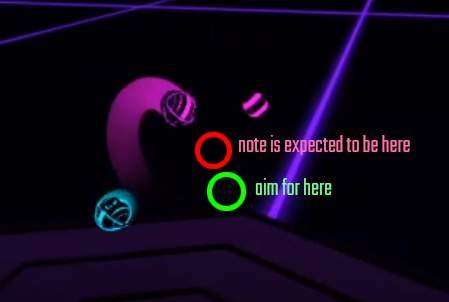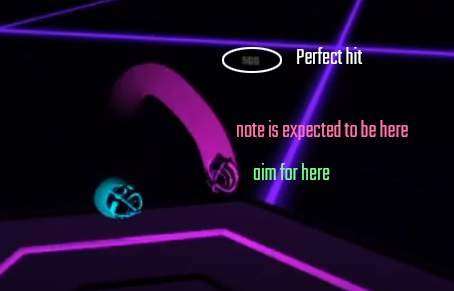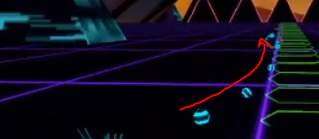
Force Mode Guide
What Is Force Mode
Synth Riders has two main game modes: rhythm and force. In rhythm mode, you need to hit notes exactly in the center. In force mode, you need to hit notes with speed instead.
When playing force mode, focus on how fast your controllers are moving when you hit notes. You don’t need to worry about hitting the center of notes in this mode.
I’ve found that smooth, consistent movements work better than trying to hit notes with a lot of power. Instead of using strength or quick wrist flicks, I recommend keeping your movements flowing continuously to generate better force.
Scoring

The colored gauge on the bottom is your force meter. Each time you hit a note, you can see the gauge fill based on how fast your controller was going at the time of impact. The left and right sides fill independently, and correspond to your left and right controllers.
Score per note is based on how full you fill the gauge when hitting the note. Perfect = green, Good = yellow, Poor = red.
Rail scoring
Rails are scored based on the initial hit. E.g. If you get a perfect on the first hit of the rail, the rail itself will be scored as a perfect, as long as you don’t drop the rail. If there are notes along the rail, you need to re-hit each note since they are scored separately.
Suggestions on How to Hit the Notes for Best Score
Overview
Even though force mode is commonly thought of as a “punching” or “boxing” mode, punching at the notes is not usually an optimal way to get a good score. The main reason for this is because after you’ve punched forward for the note, you need to retract your arm again to reset for the next note. Since scoring is based on the controller speed at note impact, if the next note hits your collider as you’re retracting your arm, you have a high chance of not having enough velocity to score a perfect hit. Similarly, it’s hard to score well using short jabs, because the velocity gets cancelled out each time you change to the opposite direction (e.g. a short punch forward and retracting it is essentially velocity forward, stop, velocity backwards, stop).
If the notes are far enough apart so that you have time to build the velocity back up before hitting the next note, then this is not as much of a problem, but you will likely have difficulties with faster and more note dense songs.
Instead of punching at the notes, I recommend thinking of it as slapping/smacking/backhanding/just generally abusing the notes with a light and quick movement. Pay attention to your force meter, because the amount of effort it takes to get a perfect isn’t very high, so you can get away with very light hits.
Individual notes
When hitting individual notes, aim to pass through the note, rather than aiming at the note itself. This is because aiming at the note will tend to cause you to slow down and/or stop just as the note approaches, which is the worst possible timing for force mode.


Groups of notes
When notes are close enough together within a pattern, it’s possible to score perfects on them using a single continuous motion, instead of trying to swipe at each note individually. There aren’t really any hard and fast rules on this, because it depends on the speed of the song and the pattern itself, but you’ll save a lot of effort and will probably get higher scores once you start recognizing which groups can be hit with a single motion.


Pattern weaving
This is just something that I personally do at times, but also it has a high chance of causing you to miss if you misjudge the size of the notes. Some patterns seem to be cleared better by weaving in between the outer/inner edges of the notes, instead of hitting through the center of all of the notes (this is usually the case for curved or jagged/jumpy patterns). It feels like I’m able to keep up consistently higher velocity by skimming the edges of the notes, so on sections of notes that are slower or places where I tend to lose velocity, I’ll switch to weaving the pattern.
Notes in a straight line
The best way that I’ve found to clear notes that are close together in a straight line is to make a circular pattern around the outside edges of the line. Note that this seems to work best (i.e. least effort) if you time your rotation to the speed at which the notes are approaching. If there is enough space between the notes to swipe back and forth to hit them, then that works too. I’ve just found that it’s harder for me to get perfects when going straight back and forth vs using circles, so I tend to do circles instead, but the back and forth swipe seems to work well for other people too.
Spirals
I tend to stick to the outer edges of spirals to give myself more space to keep up my swing velocity. For spirals that change direction, be sure to go a little past the last note of the current direction so that you can build the velocity to hit the first note of the new direction.
Rails
As mentioned in the Scoring section, each note on a rail needs to be hit individually. I’ve found that if I try to hit an on-rail note with the same timing that I use for normal individual notes, I only get a good score on it. Instead, I try to initiate hitting the rail note slightly earlier than I normally would, and either slide along the rail to hit it (like imagine pushing beads along a string) or make small circular hits. Note that in order to slide along the rail to hit the notes, you need to have enough forward/backward room to continue your velocity through the last note. I typically do this by twisting my torso so that I can bring my arm further back to have as much forward space as possible along the rail.
Improving Force
Focus on timing
This is going to sound a little weird, but I actually wish that force was called “rhythm” mode, because following the rhythm is super super important for it, especially with the new collider sizes. You want to make sure to time your movements as close to the rhythm as possible, because swinging early can cause you to not have enough velocity by the time the note hits. I personally feel like this is the number one most important thing for force, because even a small offset in your timing can cause you to get goods/poors instead of perfects.
Try using your whole body to help generate force
A lot of the momentum I use is generated through my legs and torso, and flows outward to my arms, which means that I usually initiate movement starting from the ground. I’ve found that this is a good way for me to be able to keep consistent velocity, even on slower songs, since it helps me stay on time and gives me greater control than if I were to try to initiate the movement from my arms/shoulders. It’s not great in terms of energy efficiency, since you end up moving a lot, but I feel that it contributes a lot to high force accuracy. I’d say my ratio is 60/30/10 for how much I use my legs/torso/arms respectively in most songs.
Change your scoring colours
The scoring colors for perfects, goods, and poors are all white by default, which can make it difficult to see what you scored on individual notes, since you have to focus on reading the number. If you change them to different colours, it’s easy to see at a glance what score you hit per note, which makes it easier to identify what difficulties you’re having with certain patterns and notes.
Personally, I use black for perfects and red for goods/poors. What this does is it highlights any time I didn’t score a perfect on a note, since I’ll see a flash of colour. I used to do green (perfect), yellow (good), red (poor), but switched to black/red/red after watching Moinn’s stream, and I think it’s definitely helped me improve my perfects ratio.
The force tutorial exists
If you’re having a hard time figuring out how fast you need to be hitting the notes, jump into the force tutorial and do some testing to get a feel for how you need to move! It’s a great tool, and a good way to see if you can be consistent with your hits.


THANK YOU IS NOT EVEN COMING CLOSE. I just started playing and after going from good scoring I dropped and this has helped me ALOT.SO THANKS. The way you described it and with the diagram helps so much..most just play the game Wich rely dosent help YOU HELPED ALOT